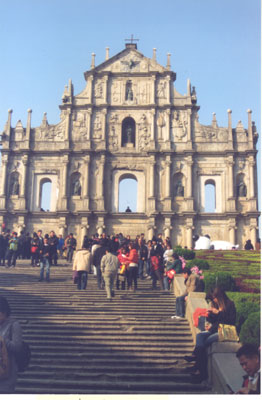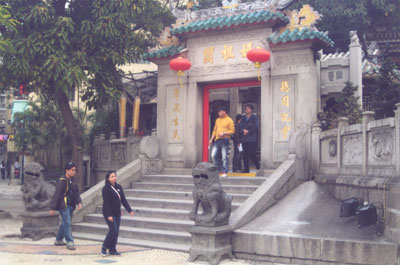Macau — blend of East and West
This item appears on page 59 of the January 2012 issue.
For more than four-and-a-half centuries Macau has occupied a unique position both in its geographical location at the mouth of the Pearl River in the South China Sea and as a link between Europe and China.
Founded by Portuguese in 1557, Macau was the first European colony on Chinese territory. It served not only as Europe’s gateway into China but as China’s “window” on the outside world that it had often shunned in the past.
Mixture of two cultures
Much from both cultures remains from that past. Cobblestone streets, cream-colored churches, and balconied buildings reminiscent of Southern Europe, particularly Portugal, blend harmoniously with brightly colored Chinese temples and sedate gardens dotted with koi ponds, pavilions and moon gates.
Macau is cognizant of its rich past and is working hard to preserve it — so different from what I found on my first visit there, in 1981, when much seemed to be in decay. In 2005 more than two dozen sites in Macau’s Historic Centre were collectively added to the UNESCO World Heritage List. Two of the most prominent and most important represent the best of both cultures: the Chinese A-Ma Temple and the Portuguese São Paulo Church.
Chinese temple
If you visit only one Chinese temple in Macau, it should be A-Ma Temple. It predates the foundation of Macau perhaps by as much as a century, when Chinese fishermen erected the original temple to the goddess Tin Hau, patroness of fishermen. (Tin Hau’s popularity accounts for the proliferation of temples in her honor in both Macau and in Hong Kong.)
In Macau, Tin Hau was called A-Ma, and the bay where her temple was situated was called A-Ma-Gao, an easy step to eventually becoming “Macao,” or “Macau.”
The temple complex rises in terraces up a hillside beside the inner harbor, with winding pathways and stone stairways linking the terraces. Lining the pathways is an array of pavilions and temples, each dedicated to a different deity.
Some of the temples are Confucian, some Buddhist, some Taoist. There are even a few dedicated to popular folk gods. Each is crowded with devotees. Interspersed among the temples and pavilions are incense burners and stalls selling devotional items, candles and bunches of incense sticks.
Even if one does not understand the intricacies of Chinese temple worship and etiquette, it is a rewarding experience to climb to each terrace, pausing at each small temple to light candles or incense sticks and to ask the resident deity for a favor or to commemorate a deceased friend or relative.
Portuguese church
In contrast is São Paulo. The Jesuits arrived in Macau in 1565 hard on the heels of the first Portuguese sailors and traders. They built the College of St. Paul in 1594 (the first Western university in the Far East), the Church of Mater Dei (Mother of God) between 1602 and 1640 and the fortress called Fortaleza do Monte in 1617. When the Jesuits were expelled from Macau in 1762, these structures became military barracks.
An immense blaze in 1835 destroyed everything — except for the stone facade of the church. It has become synonymous with Macau, identifiable as the symbol of the city.
This facade is magnificent. It’s full of Christian symbolism centering on the Trinity (God the Father, Jesus Christ and the Holy Spirit) and on the Virgin Mary. But it also incorporates Asian symbols, including the peony, representing China, and the chrysanthemum, representing Japan and the stonemasons who helped build the church.
Also part of the facade are statues of four prominent Jesuits, including St. Francis Xavier and St. Ignatius Loyola, founder of the Jesuit order.
A long stone stairway leads up to the facade, enhancing its architectural grandeur. Locals and tourists congregate there at all hours. It’s one of the “in” spots in Macau.
There’s a small Museum of Sacred Art in what was once the church crypt, which houses the only painting to survive the 1835 fire, a painting of the Archangel Michael by a 17th-century Japanese Christian. Michael looks somewhat like a samurai warrior.
More treasures
Among other sights I visited during my four days in Macau in January 2011 — most of them on the UNESCO World Heritage List — were four churches with their origins in the 16th century (St. Augustine’s, St. Lawrence’s, St. Anthony’s and St. Dominic’s); a small section of surviving 16th-century walls; the 19th-century Lou Kau Mansion, belonging to a wealthy merchant; the 17th-century Guia Fortress and its adjacent 1865 lighthouse, and the incomparable Largo do Senado, Macau’s main square, dominated by black-and-white wavy mosaic pavement.
On the Largo are the 1569 Santa Casa de Misericórdia and the late-18th-century Leal Senado, neoclassical in style and considered the best example of Portuguese architecture in Macau. Be sure to see its interior courtyard lined with blue-and-white azulejos, Portuguese tiles.
If you go…
On our 2011 visit, my husband and I stayed at the Pousada de Mong-Há (Colina de Mong-Há, Macau, China; phone 853 2851 5222, fax 853 2855 6925), built on a hill near the site of an old Portuguese fortress.
This pousada (the word means “inn” in Portuguese) is very special. It is beautiful, it’s a bargain and it’s run by the Institute for Tourism Studies, a college training students for Macau’s burgeoning tourism industry. Rooms are grouped around tiled mini-courtyards. The dining room, too, is lined with azulejos; they depict the months of the year.
Standard room prices ranged from $75 to $100 per night, depending on the day of the week. Our suite, consisting of a living room, bedroom and enormous bathroom, overlooked the institute’s garden. Suite prices ranged from $137 to $187 per night.
Service was exceptional. The student employees aim to please.
Don’t miss the chance to sample Macanese cuisine at the pousada’s Friday night buffet, especially if you like seafood. Our buffet dinner for two, with drinks, cost about $50.
Macau is easy to reach from Hong Kong by hydrofoil (phone 800 3628 3628, www.turbojet.com.hk), which runs every 15 minutes between 7 a.m. and midnight. The trip takes just one hour.
Prices start at HKD134 (about $17). There is also luxury-class hydrofoil service, with prices beginning at HKD212 ($26.50). It’s worth the price difference for the extra comfort and the absence of crowding.


